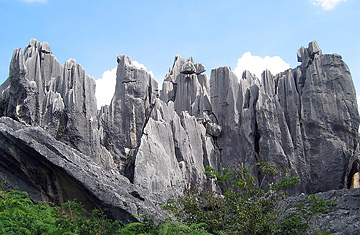
South China Karst
Preserving the world's truly great places has never been easy, often because it's hard to determine just what they are. One person's verdant grassland might be another's development site; where you see a mountain range, someone else might see a coal vein. Sorting out such matters can become impossible — especially when the debates take place across borders, as preservationists in one country plead with another not to burn a grassland or dam a river or tear down a thousand-year-old temple.
That's where the World Heritage Committee comes in. Officially established by the United Nations in 1972 as part of the Convention on the Protection of the World Cultural and Natural Heritage, the committee meets once a year to choose the world's natural or human-made wonders in the greatest need of protection and assigning them to a sort of endangered-species list that makes them eligible for international stewardship and restoration funds. In the 35 years since the heritage list was established, 830 sites have been designated, including the Statue of Liberty, the Great Wall of China and Mount Kenya National Park in Africa. From June 23 to July 2, the committee will be meeting again, this time in Christchurch, New Zealand, to consider 45 new sites nominated by 39 countries as candidates to be placed under the U.N.'s protective wing.
The idea for a World Heritage List was hatched in the late 1950s, when the ancient Abu Simbel temples in Egypt were being threatened by a small dam. Frustrated by the Egyptian government's lack of action to protect the ancient buildings, the United Nations Educational, Scientific and Cultural Organization (UNESCO), launched a worldwide campaign that saved the temples by relocating them to higher ground. Today, the process is a good deal more official than that — almost like the Oscars of the environment. Any country is eligible to send in a list of nominees for protection. The candidates are then independently evaluated by two organizations — World Conservation Union and the International Council on Monuments and Sites — which in turn make a recommendation to the World Heritage Committee. That body votes on which sites will become new members; last year, 18 were accepted. "It really is a democratic process," says Christian Manhart, chief of communication, education and partnerships at the World Heritage Center in Paris.
Once a place is inscribed on the list, it not only benefits from the media attention and tourist revenue that such notoriety can bring, it also becomes eligible for a piece of UNESCO's preservation fund. In 2001, the world recoiled when the Taliban destroyed two 6th century, 150-ft. statues of Buddha carved into the mountainside in the Bamiyan Valley in Afghanistan. Since it was inscribed on the list, the site has received more than $4 million to help with reconstruction and to hire a sculptor to re-carve some of the damaged stone. "Countries are under a lot of pressure to get on the list, because of the funding," says Manhart. The photo gallery below includes pictures of some of the sites being considered for protection this year. Browse through, vote for your favorites and take a minute while doing so to contemplate what the world would be like without its most remarkable — and destructible — places.
